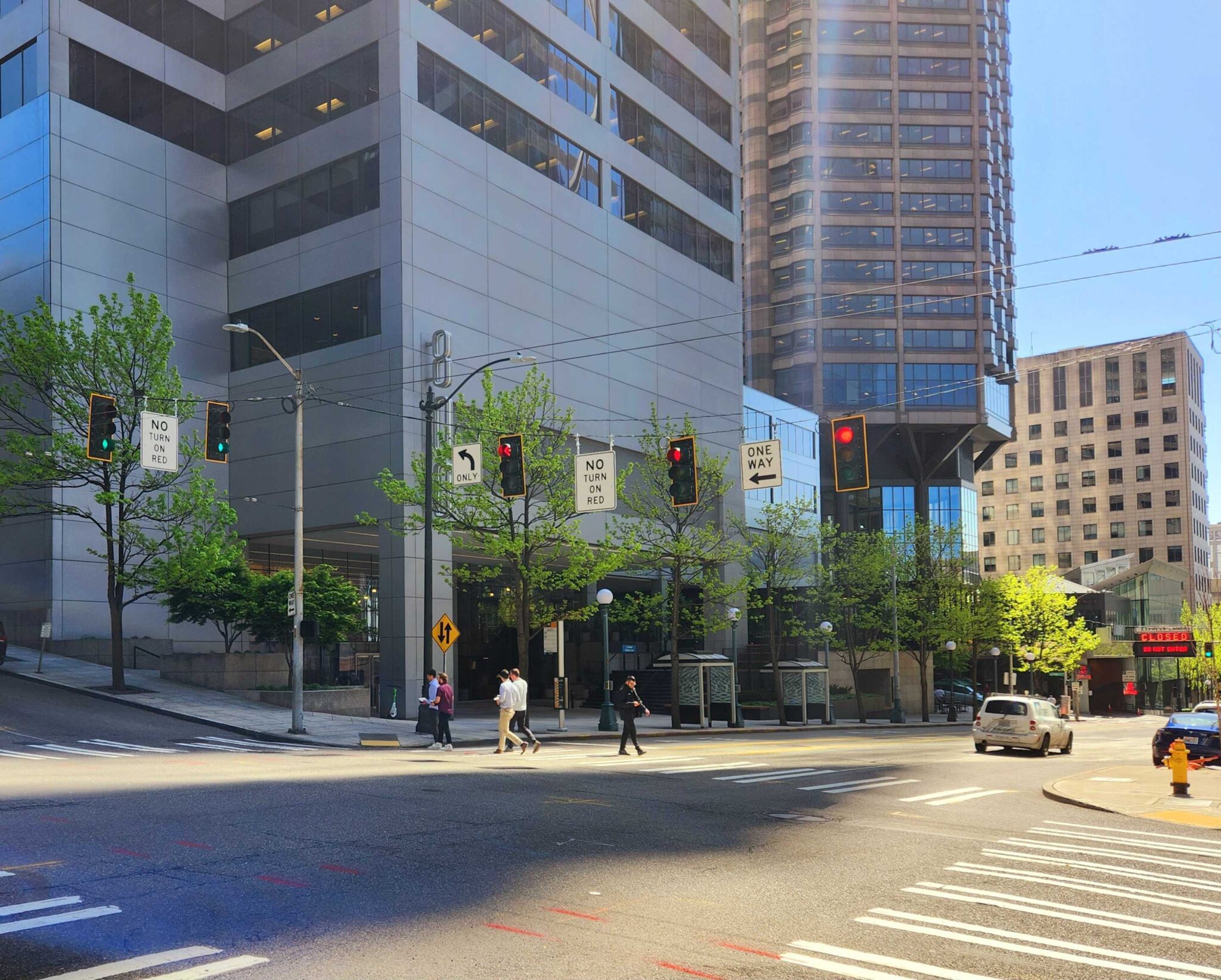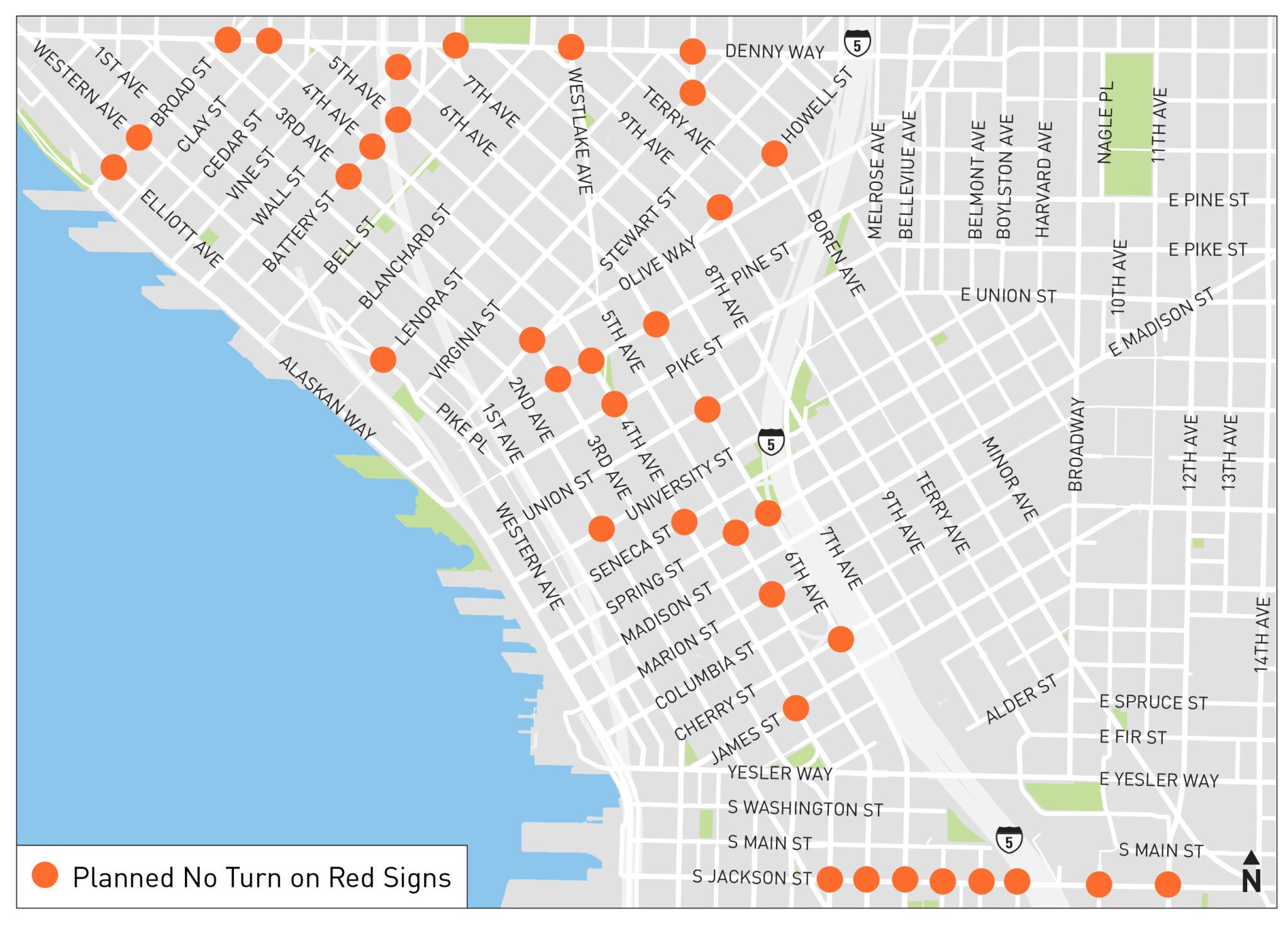 Pedestrians cross a street in downtown Seattle. Credit: SDOT
Pedestrians cross a street in downtown Seattle. Credit: SDOT Blog stats: 950 words I 5-minute read
Editor’s note (September 15, 2023): We originally published this blog post on May 4, 2023, and have updated it since then with the latest information.
At-a-glance
- We’ve planned 59 new No Turn on Red signs at 17 intersections along Aurora Ave N.
- We’re two-thirds of the way through installing No Turn on Red signs at 41 intersections downtown. Twenty-eight locations are complete with the rest happening before the July Major League Baseball All Star Week.
- This momentum building action from the Vision Zero Top-to-Bottom review reduces right turn on red crashes which account for 9% of all collisions with people crossing the street at Seattle’s signalized intersections.
- A new policy to advance this proven safety measure will lead to more turn on red restrictions being rolled out in pedestrian dense neighborhoods throughout the city over the next year.
We’re adding 59 new No Turn on Red signs at multiple intersections along Aurora Ave N!
One of the primary pedestrian collision patterns on the corridor involves conflicts between turning vehicles and pedestrians crossing in the crosswalks at signalized intersections. Restricting right turns on red helps to reduce these conflicts.
We will install No Turn on Red at most signalized intersections throughout the corridor including 59 new no turn on red signs at 17 intersections along the corridor.

We plan on installing these signs by the end of 2023 as a near-term improvement of the greater Aurora Ave Project.
Original Post (May 4, 2023)
To meet our commitment to take immediate actions to support Vision Zero and enhance road safety, we developed a new policy and have started expanding No Turn on Red restrictions at more than 40 downtown intersections.
We recently published a top-to-bottom review of our Vision Zero initiative, which aims to end traffic related deaths and serious injuries on city streets by 2030. This review was commissioned by Mayor Bruce Harrell and SDOT Director Greg Spotts to evaluate our processes after seeing fatal and serious injury crashes increase in recent years.
One of the first momentum-building actions to come out of the review is to expand the use of No Turn on Red restrictions at signalized intersections throughout the city.
Limiting turns on red lights reduces conflict between people driving and people walking and rolling. In Seattle, right turn on red crashes account for 9% of all collisions with people crossing the street at signals. By implementing No Turn on Red at intersections, we create a more consistent and predictable crossing experience for everyone.
Implementing No Turn on Red restrictions make a small, but meaningful, change to the traffic signal patterns at intersections. The change should not lead to noticeable delays for drivers but makes a big difference on the comfort and safety of the most vulnerable travelers that are walking or rolling, especially when combined with other safety measures at intersections such as leading pedestrian intervals (LPI) and traffic calming treatments.
We are nearly finished adding No Turn on Red at more than 40 downtown intersections.
At the start of 2023, there were about 100 Seattle intersections where it was illegal to turn right during a red light. Going forward, people can expect to see these signs more often.
As a first step, No Turn on Red signs will be installed at 41 signalized intersections across downtown. We have already finished more than two-thirds of these locations (28 intersections), with the remaining scheduled to be completed by the end of June.
These initial locations were selected to provide additional continuity of No Turn on Red along corridors and prioritize areas with high pedestrian volumes. We are currently evaluating other potential locations for the next phase of installations.

Our new policy will make No Turn on Red restrictions easier to implement citywide.
Along with the initial installation of signs at 41 locations downtown, our new policy establishes the broad use of No Turn on Red restrictions at intersections throughout the city.
SDOT will evaluate and implement changes when:
- New traffic signals are installed,
- Operations at signalized intersections are modified,
- Or SDOT programs, such as Safe Routes to School, prioritize locations.
The general guideline for this evaluation will be to add No Turn on Red restrictions unless there is a significant operational reason not to. Delay to vehicles will not generally be considered unless necessary for coordination with partner agencies (like transit service). At some intersections, it may not be feasible to install a No Turn on Red sign until additional mitigation can be completed, such as signal timing adjustments.
The policy will also ensure that all existing and future projects will evaluate including No Turn on Red signs at intersections within their scope, as part of the project.
We are taking action to improve walkability and safety as part of our work to draw people to the heart of Seattle and make downtown a welcoming place. Together, we can make downtown a vibrant, dynamic, and safe space for all.
Seattle Mayor Bruce Harrell
Let’s not trade people’s safety so people in cars can save a few seconds of waiting for their turn to go. Adding 40 No Turn on Red intersections downtown is the first step in our plan to expand this proven safety measure to pedestrian dense neighborhoods.
SDOT Director Greg Spotts
Turning right at red lights is linked to a 60% increase in people being hit by turning cars.
Turning right at a red light was illegal in most cities, including Seattle, until a few decades ago. Seattle did not make it legal to turn right at a red light until 1959. In 1975, the federal Energy Policy and Conservation Act required all states to allow right turns on red to reduce fuel consumption, estimating a travel time savings of 1-5 seconds for turning vehicles.
This 1981 US Department of Transportation report and other studies found concerning trends after the new law. These studies indicated that 60% more pedestrians and twice as many bicyclists are hit by turning cars at intersections where people in cars are allowed to turn during a red light.
Another recent study of 100 intersections with No Turn on Red restriction in Washington D.C. was published in the Institute of Transportation Engineers Journal in 2022 found that there was minimal increase in waiting for vehicle traffic at intersections where right turns on red were prohibited.
Look for these changes in Seattle neighborhoods across the city soon.
As part of our commitment to Vision Zero, we will continue to evaluate and install No Turn on Red signs in other pedestrian dense neighborhoods throughout the city over the next year.